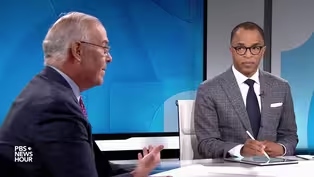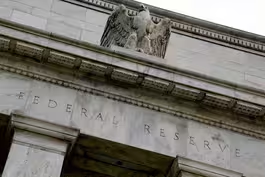
Obstacles prevent homeless veterans from finding housing
Clip: 4/28/2023 | 8m 59sVideo has Closed Captions
The obstacles preventing homeless veterans from finding housing in Los Angeles
On any given night, more than 65,000 unhoused people are living in Los Angeles. There is not enough affordable housing, and even when there is, some people struggle to get into those units, including veterans on disability. Stephanie Sy looks at some of the obstacles leading to LA's homeless population, the largest in the country.
Problems playing video? | Closed Captioning Feedback
Problems playing video? | Closed Captioning Feedback
Major corporate funding for the PBS News Hour is provided by BDO, BNSF, Consumer Cellular, American Cruise Lines, and Raymond James. Funding for the PBS NewsHour Weekend is provided by...

Obstacles prevent homeless veterans from finding housing
Clip: 4/28/2023 | 8m 59sVideo has Closed Captions
On any given night, more than 65,000 unhoused people are living in Los Angeles. There is not enough affordable housing, and even when there is, some people struggle to get into those units, including veterans on disability. Stephanie Sy looks at some of the obstacles leading to LA's homeless population, the largest in the country.
Problems playing video? | Closed Captioning Feedback
How to Watch PBS News Hour
PBS News Hour is available to stream on pbs.org and the free PBS App, available on iPhone, Apple TV, Android TV, Android smartphones, Amazon Fire TV, Amazon Fire Tablet, Roku, Samsung Smart TV, and Vizio.
Providing Support for PBS.org
Learn Moreabout PBS online sponsorshipGEOFF BENNETT: On any given night, there are more than 65,000 homeless people living in Los Angeles.
There is not enough affordable housing, and, even when there is, some people struggle to get into those units, including veterans on disability.
Stephanie Sy looks at some of the obstacles leading to L.A.'s homeless population, the largest in the country.
STEPHANIE SY: On the sprawling 388-acre campus of the West Los Angeles VA, dotted with palm trees, a construction boom under way.
Three new buildings have gone up this year to provide qualified veterans low-income housing.
Sixty-three-year old Jack Vicente has been settled in his gleaming new studio apartment for a month.
The Army vet was working as a bellman at a hotel when he suffered a back injury and was let go from his job.
JACK VICENTE, Recently Housed Veteran: And that's what led to me being pretty much homeless for the next four or five months, until I was able to go to the VA. And the VA helped me get into a lovely, secure place like this.
In my opinion, the promise that they made when I joined up, they're really keeping their word now.
STEPHANIE SY: But there are other veterans who feel the opposite.
Where are you living now?
LAVON JOHNSON, Unhoused Veteran: Right there.
STEPHANIE SY: Thirty-six-year old Lavon Johnson, an Army veteran lives right outside the VA campus in a tent.
You have been back here for about, what, a week-and-a half?
LAVON JOHNSON: About that.
STEPHANIE SY: He was living in one of these tiny shelters on the VA campus, but he says it caught fire and he was removed from the temporary housing program.
Johnson has been chronically homeless for more than a decade.
Even as new apartment buildings on go up on the VA campus, he is locked out.
You applied to stay at one of these buildings, and you were rejected?
LAVON JOHNSON: Yes.
STEPHANIE SY: Why?
LAVON JOHNSON: My annual yearly income was not -- was not -- was too much by $200.
STEPHANIE SY: Johnson's income is actually his monthly disability check.
While deployed in Iraq with the 1st Cavalry Division, he says his unit was hit by a rocket.
LAVON JOHNSON: I get shot back.
I land on my feet.
Then I fell over.
I remember falling over, hitting my head.
And I -- then it's just blank after that.
STEPHANIE SY: Due to a diagnosis of serious mental illness, he receives full compensation of over $4,000 a month.
So, you would think that would be enough to rent an apartment here?
LAVON JOHNSON: Not in California.
Plus, I have bills and other debts I have to pay off every month too.
So, like, all my money is gone.
I don't have anything for myself for the month.
It's just a vicious cycle.
STEPHANIE SY: Johnson falls into a category of veterans who stand on a so-called benefits cliff.
He gets so much in disability compensation that other essentials, like housing, fall off.
It is estimated 8,000 homeless veterans around the country may lose out on low-income housing opportunities because their benefits put them over income caps.
KEITH HARRIS, Department of Veterans Affairs: This particular building has very strict eligibility criteria.
STEPHANIE SY: We met Keith Harris, who oversees the VA's efforts to house homeless veterans in L.A., in one of the shiny new apartments on campus.
A veteran has to be at least 62 and make under $42,000 a year to qualify to live in this building.
KEITH HARRIS: We know what the solutions are.
Either we get eligibility caps raised, so that veterans who are receiving VA benefits can qualify, or we stop counting VA benefits as income.
STEPHANIE SY: Harris says another problem is that other dedicated housing lies in parts of L.A. where many unhoused vets don't want to live, so they don't use the affordable housing vouchers that are available to them.
KEITH HARRIS: There are close to 50 buildings.
There are a couple hundred vacancies in those buildings.
STEPHANIE SY: Why are there vacancies?
KEITH HARRIS: It's maddening.
I want to acknowledge it's very frustrating, because you have got thousands of homeless veterans.
You have got hundreds of vacant units.
You have got thousands of unused vouchers.
The biggest problem filling those is one of location.
Many of those are far away from the medical center.
STEPHANIE SY: And the medical center is located on the Westside of Los Angeles, where the average rent for a one-bedroom apartment is more than $3,000 a month.
A housing voucher or disability check doesn't go far here.
KEITH HARRIS: There simply aren't enough units for everybody who needs one, much less could afford one.
STEPHANIE SY: As challenging as it is to build affordable housing on the VA campus, it is even more onerous elsewhere in Los Angeles.
Between historically discriminatory zoning laws and community resistance, it's an uphill battle.
Few know that better than Dora Leong Gallo, the head of A Community of Friends, which has been providing housing for people with mental health disorders for 35 years.
Just like some veterans with disabilities, some people with serious mental illnesses in the general population benefit from having support services where they live.
A quarter of L.A.'s homeless population has these disorders.
DORA LEONG GALLO, President and CEO, A Community of Friends: The concept was to build apartment communities where people had a lease and that there would be services on site in the buildings to help ensure that people had the services they need to live independently.
STEPHANIE SY: Leong Gallo walks us through the lengthy process of developing what's called permanent supportive housing.
DORA LEONG GALLO: The first thing we have to do is find property.
STEPHANIE SY: That's also the first roadblock.
DORA LEONG GALLO: Because were kind of restricted in where we can build apartment buildings, it costs -- it drives the cost higher as well, because we are all competing for the same limited land.
STEPHANIE SY: According to one study, more than 70 percent of residential areas in the L.A. area are zoned for single-family homes, a planning policy that has roots in racial discrimination.
DORA LEONG GALLO: At the same time, simultaneously, we are looking for financing.
STEPHANIE SY: That's the next roadblock.
A nonprofit has to compete for funding from various sources, all with different requirements, restrictions, and timelines.
DORA LEONG GALLO: And along the same time, we are also meeting with the community.
STEPHANIE SY: And that, many housing developers say, is one of the biggest roadblocks.
Even while Californians have approved measures to increase funding to address homelessness, not-in-my-backyard attitudes have blocked or delayed many projects.
DORA LEONG GALLO: When you don't allow this type of housing to be built, then people are forced to live further away.
People are forced to live in their cars.
STEPHANIE SY: Seventy-year-old Wallace Richardson had been living out of his truck for more than a year, when he was linked up with one of the 50 buildings developed by A Community of Friends.
He's been in his Silver Lake apartment for more than a decade.
One of his last jobs was with AmeriCorps.
WALLACE RICHARDSON (Los Angeles Resident): During the time that I was an outreach worker, I got a firsthand look at myself.
I thought that I was mentally sane, but I wasn't.
You know, I had issues.
And the issues I had was coming up from being an abused child.
STEPHANIE SY: What has it been like to have this stable housing for the last 10 years?
WALLACE RICHARDSON: It has made all the difference in the world.
In fact, it has saved my life, because I was on a downhill spiral.
STEPHANIE SY: Back near the VA campus, Lavon Johnson is still waiting for his life jacket, and he's losing his patience.
LAVON JOHNSON: I can't sit still, knowing that people like me are getting screwed over blatantly by them.
STEPHANIE SY: He's part of a recent lawsuit that accuses the VA of not providing enough affordable housing to the neediest veterans.
The plaintiffs demand 3,500 permanent supportive units on or near the VA campus.
My understanding is, there are lawsuit's going back to 2011 saying, why isn't the VA doing more to house homeless veterans here?
Why now?
Why just in the last couple of years?
KEITH HARRIS: The draft master plan was put into place as part of resolving the first lawsuit.
And it had a very aggressive timeline on the units that would be built, turned out very unrealistically so.
STEPHANIE SY: The VA realized recently that if sites were prepared ahead of time for developers, they could speed up, the process.
They have already spent $70 million on things like leveling land and adding underground utilities to make sites build-ready.
KEITH HARRIS: That's why it looks like a rush.
This is the way it should have been happening all along.
STEPHANIE SY: The agency is aiming to complete 1,200 units by 2030.
Whether one of those units is in Lavon Johnson's future remains in doubt.
For the "PBS NewsHour," I'm Stephanie Sy in Los Angeles.
Battles over reproductive, transgender rights in states
Video has Closed Captions
Clip: 4/28/2023 | 5m 47s | Battles over reproductive, transgender rights fought in state legislatures (5m 47s)
Brooks and Capehart on the possible Biden-Trump rematch
Video has Closed Captions
Clip: 4/28/2023 | 9m 58s | Brooks and Capehart on the possible Biden-Trump rematch and Tucker Carlson's ouster (9m 58s)
Fed blames bank collapse on mismanagement, oversight failure
Video has Closed Captions
Clip: 4/28/2023 | 6m 8s | Fed blames mismanagement and oversight failures for Silicon Valley Bank collapse (6m 8s)
Judy Blume describes latest wave of book bans and censorship
Video has Closed Captions
Clip: 4/28/2023 | 7m 51s | The new film "Are You There, God? It's Me, Margaret," is shining a spotlight on Judy Blume (7m 51s)
Russian missile and drone attacks kill civilians in Ukraine
Video has Closed Captions
Clip: 4/28/2023 | 6m 11s | Russian attacks kill more civilians as Ukraine prepares for a major counteroffensive (6m 11s)
Providing Support for PBS.org
Learn Moreabout PBS online sponsorship
- News and Public Affairs

FRONTLINE is investigative journalism that questions, explains and changes our world.

- News and Public Affairs

Amanpour and Company features conversations with leaders and decision makers.












Support for PBS provided by:
Major corporate funding for the PBS News Hour is provided by BDO, BNSF, Consumer Cellular, American Cruise Lines, and Raymond James. Funding for the PBS NewsHour Weekend is provided by...




